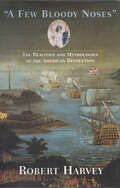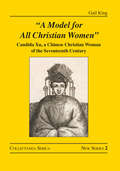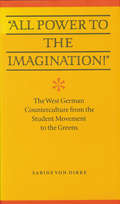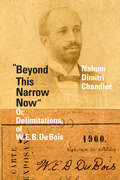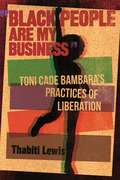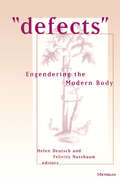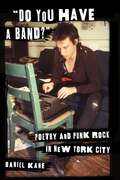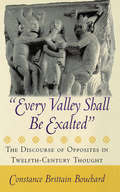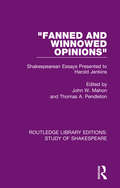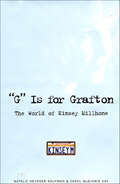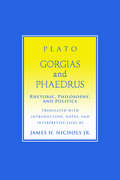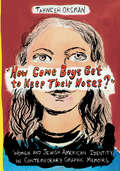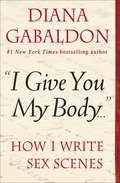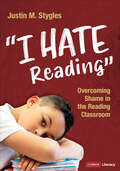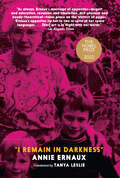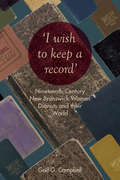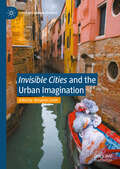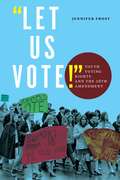- Table View
- List View
!Te Toca!: A New Communicative Spanish Course
by Mark Allinson Richard Pym""Languages are best learned when real-world information becomes the focus of students' activities. In this respect, !Te Toca! definitely encourages advanced learners to focus on exchanging real-life information about the world around them. Moreover, since the topics and issues presented in the book are controversial in nature, they seem especially appealing to college students."" Dr Maria Jesus Amores, University of West Virginia!Te Toca! is a thoroughly innovative approach to advanced language learning. Imaginative, exciting and fun, it uses language simulations to take students into a virtual Spanish-speaking world where they adopt a new Spanish or Latin-American identity. Creating a learning environment in which they need to use Spanish to solve a problem or engage in debate, the language simulations draw and expand on students' linguistic, communication, and information-gathering skills.Covering a variety of engaging topics, the simulations literally put the students centre-stage, requiring them to think on their feet and speak exclusively in Spanish. The topics revolve around contentious issues and each chapter includes a simulation exercise with all its associated documents, as well as a lead text, comprehension questions, a guide to relevant points of functional grammar, associated exercises, a glossary of terms, and suggestions for written work.
"A Few Bloody Noses": The Realities and Mythologies of the American Revolution
by Robert HarveyThe noted British historian and author of Liberators offers a colorful, enlightening and myth-busting history of the American Revolution.According to King George III, Britain merely wanted to give America “a few bloody noses” and return to mutual cooperation. Yet the ensuing uprising led to the creation of the United States, the most powerful country in the modern world. In “A Few Bloody Noses”, Robert Harvey challenges conventional views of the American Revolution in almost every aspect—why it happened; who was winning and when; the characters of the principal protagonists; and the role of Native Americans and enslaved people. Harvey takes a penetrating look at a war that was both vicious and confused, bloody and protracted, and marred on both sides by incompetence and bad faith. He underscores the effect of the Revolution on the settlers in America, and those at home in Britain—the country that the settlers had left behind, and to which many returned. The result is an extraordinarily fascinating and thoroughly readable account.
"A Model for All Christian Women": Candida Xu, a Chinese Christian Woman of the Seventeenth Century (Collectanea Serica. New Series #2)
by Gail KingThis biography of Candida Xu (1607–1680), granddaughter of the prominent Chinese Christian convert and statesman Xu Guangqi (1562–1633) and foremost Chinese Christian woman of the seventeenth century, is based on the biography of Candida Xu titled Histoire d’une dame chrétienne de la Chine (Paris, 1688) written by her confessor Philippe Couplet, S.J. (1623–1693), an obituary of his mother and other writings by her eldest son, and the Xu family history. Using these as well as other relevant European missionary and Chinese language sources, Candida Xu’s life as daughter, wife, mother, and generous contributor to the Christian Church is recounted. Events in her life are set in the context of historical and religious circumstances in China at the time. Consideration of the situation of women, particularly Christian women, draws out how Candida Xu’s faith helped her and other believing Christian women to gain greater freedom of choice and action.
"All Power to the Imagination!": Art and Politics in the West German Counterculture from the Student Movement to the Greens (Modern German Culture And Literature Ser.)
by Sabine Von Dirke“All Power to the Imagination!” is a history of the counterculture’s immensely influential role in West German cultural and political life. Sabine von Dirke opens with an examination of nascent countercultural movements in West Germany during the 1950s. She then moves to a nuanced account of the student movement of the 1960s, describing its adaptation of the theories of Marcuse, Adorno, and Benjamin, then recounting its attack on “bourgeois” notions of the autonomy of art and culture. She next examines the subsequent development of a radical aesthetic and the effects of left-wing terrorism on Germany’s political climate. Later chapters focus on die tageszeitung, the ecology movement, and the rise of the Green Party. Von Dirke concludes by asking whether the evolution that this book traces—from Marxist-influenced critiques of culture and society to more diverse, less doctrinaire left-wing positions—represents progress or a betrayal of radical ideals. An ambitious study of the German left, this book is an important contribution to our understanding of postwar European history.
"Beyond This Narrow Now": Or, Delimitations, of W. E. B. Du Bois
by Nahum Dimitri ChandlerIn “Beyond This Narrow Now” Nahum Dimitri Chandler shows that the premises of W. E. B. Du Bois's thinking at the turn of the twentieth century stand as fundamental references for the whole itinerary of his thought. Opening with a distinct approach to the legacy of Du Bois, Chandler proceeds through a series of close readings of Du Bois's early essays, previously unpublished or seldom studied, with discrete annotations of The Souls of Black Folk: Essays and Sketches of 1903, elucidating and elaborating basic epistemological terms of his thought. With theoretical attention to how the African American stands as an example of possibility for Du Bois and renders problematic traditional ontological thought, Chandler also proposes that Du Bois's most well-known phrase—“the problem of the color line”—sustains more conceptual depth than has yet been understood, with pertinence for our accounts of modern systems of enslavement and imperial colonialism and the incipient moments of modern capitalization. Chandler's work exemplifies a more profound engagement with Du Bois, demonstrating that he must be re-read, appreciated, and studied anew as a philosophical writer and thinker contemporary to our time.
"Black People Are My Business": Toni Cade Bambara's Practices of Liberation (African American Life Series)
by Thabiti Lewis"Black People Are My Business": Toni Cade Bambara’s Practices of Liberation studies the works of Bambara (1939–1995), an author, documentary filmmaker, social activist, and professor. Thabiti Lewis’s analysis serves as a cultural biography, examining the liberation impulses in Bambara’s writing, which is concerned with practices that advance the material value of the African American experience and exploring the introspection between artist production and social justice. This is the first monograph that focuses on Bambara’s unique approach and important literary contribution to 1970s and 1980s African American literature. It explores her unique nationalist, feminist, Marxist, and spiritualist ethos, which cleared space for many innovations found in black women’s fiction. Divided into five chapters, Lewis’s study relies on Bambara’s voice (from interviews and essays) to craft a "spiritual wholeness aesthetic"—a set of principles that comes out of her practices of liberation and entail family, faith, feeling, and freedom—that reveals her ability to interweave ethnic identity, politics, and community engagement and responsibility with the impetus of balancing black male and female identity influences and interactions within and outside the community. One key feature of Bambara’s work is the concentration on women as cultural workers whereby her notion of spiritual wholeness upends what has become a scholarly distinction between feminism and black nationalism. Bambara’s fiction situates her as a pivotal voice within the Black Arts Movement and contemporary African American literature. Bambara is an understudied and important artistic voice whose aversion to playing it safe both personified and challenged the boundaries of black nationalism and feminism. "Black People Are My Business" is a wonderful addition to any reader’s list, especially those interested in African American literary and cultural studies.
"Defects": Engendering the Modern Body (Corporealities: Discourses Of Disability)
by Felicity Nussbaum Helen Deutsch"Defects" brings together essays on the emergence of the concept of monstrosity in the eighteenth century and the ways it paralleled the emergence of notions of sexual difference. Women, declared a mid-eighteenth-century vindication, have been regarded since Aristotle as deformed amphibious things, "neither more or less than Monsters" (Beauty's Triumph 1758). This alliance of monstrosity with misogyny, along with the definition of sexual difference as aberration, is the starting point for this volume's investigation of monstrosity's cultural work in the eighteenth century and its simultaneous mapping and troubling of the range of differences. This collection investigates the conceptual and geographical mapping of early modern and Enlightenment ideas of monstrosity onto a range of differences that contested established categories. The essays consider the representations and material dimensions of phenomena as diverse as femininity and disfigurement, the material imagination and monstrous birth, ugliness as an aesthetic category, deafness and theories of sign language, and the exotic, racialized deformed. Collectively, they demonstrate that the emergence of sexual difference is inextricably intertwined with the emergence of a category of the human that is imagined and deformed, monstrous, and ugly. Contributors include Barbara Benedict, Jill Campbell, Elizabeth Heckendorn Cook, Lennard Davis, Helen Deutsch, Robert Jones, Cora Kaplan, Nicholas Mirzoeff, Felicity Nussbaum, Stephen Pender, and Joel Reed.
"Do You Have a Band?": Poetry and Punk Rock in New York City
by Daniel KaneDuring the late 1960s, throughout the 1970s, and into the 1980s, New York City poets and musicians played together, published each other, and inspired one another to create groundbreaking art. In "Do You Have a Band?", Daniel Kane reads deeply across poetry and punk music to capture this compelling exchange and its challenge to the status of the visionary artist, the cultural capital of poetry, and the lines dividing sung lyric from page-bound poem.Kane reveals how the new sounds of proto-punk and punk music found their way into the poetry of the 1960s and 1970s downtown scene, enabling writers to develop fresh ideas for their own poetics and performance styles. Likewise, groups like The Fugs and the Velvet Underground drew on writers as varied as William Blake and Delmore Schwartz for their lyrics. Drawing on a range of archival materials and oral interviews, Kane also shows how and why punk musicians drew on and resisted French Symbolist writing, the vatic resonance of the Beat chant, and, most surprisingly and complexly, the New York Schools of poetry. In bringing together the music and writing of Richard Hell, Patti Smith, and Jim Carroll with readings of poetry by Anne Waldman, Eileen Myles, Ted Berrigan, John Giorno, and Dennis Cooper, Kane provides a fascinating history of this crucial period in postwar American culture and the cultural life of New York City.
"Every Valley Shall Be Exalted": The Discourse of Opposites in Twelfth-Century Thought
by Constance Brittain BouchardIn high medieval France, men and women saw the world around them as the product of tensions between opposites. Imbued with a Christian culture in which a penniless preacher was also the King of Kings and the last were expected to be first, twelfth-century thinkers brought order to their lives through the creation of opposing categories. In a highly original work, Constance Brittain Bouchard examines this poorly understood component of twelfth-century thought, one responsible, in her view, for the fundamental strangeness of that culture to modern thinking.Scholars have long recognized that dialectical reasoning was the basic approach to philosophical, legal, and theological matters in the high Middle Ages. Bouchard argues that this way of thinking and categorizing—which she terms a "discourse of opposites"—permeated all aspects of medieval thought. She rejects suggestions that it was the result of imprecision, and provides evidence that people of that era sought not to reconcile opposing categories but rather to maintain them.Bouchard scrutinizes the medieval use of opposites in five broad areas: scholasticism, romance, legal disputes, conversion, and the construction of gender. Drawing on research in a series of previously unedited charters and the earliest glossa manuscripts, she demonstrates that this method of constructing reality was a constitutive element of the thought of the period.
"Fanned and Winnowed Opinions": Shakespearean Essays Presented to Harold Jenkins (Routledge Library Editions: Study of Shakespeare)
by John W. Mahon and Thomas A. PendletonOriginally published in 1987, "Fanned and Winnowed Opinions" celebrates the scholarship of Professor Harold Jenkins, one of this century’s foremost editors and critics of Shakespeare. All of the essays address Shakespearean topics, and many of the sixteen focus on the years between 1595 and 1605, the period on which much of Professor Jenkin’s work centers: there are, appropriately, three essays on Hamlet. A variety of critical approaches is represented, including the Freudian and the feminist; some essays focus on one play, while others take a thematic approach. Comedies, histories, and tragedies all come under consideration. The contributors include many distinguished scholars, some of whom studied under Professor Jenkins or edited volumes of the Arden Shakespeare under his direction. All of the contributions were specifically written for the Festschrift and had not appeared in print before. In addition to the scholarly essays, the volume features an introduction with an appreciative review of Harold Jenkins’ career and a complete bibliography of his works.
"G" Is for Grafton: The World of Kinsey Millhone
by Natalie Hevener Kaufman Carol Mcginnis KayIn this well cited and extraordinarily researched revised edition, the authors have collected every fact about America's favorite female sleuth, Kinsey Millhone. Collaborating and consulting with Sue Grafton, the author of the Kinsey Millhone alphabet mysteries and the creator of Kinsey, the authors give Kinsey fans a notable reference for that once mentioned fact they're just dying to know. In which book was a hit man after Kinsey? What does Kinsey think of killing? Who are Kinsey's friends? What does Kinsey laugh at? Where did Kinsey receive her P.I. training? The answers to these questions and hundreds more await readers of "G" Is for Grafton. The book also includes a chapter on Grafton's writing style and Grafton's thoughts on Kinsey. Updated through "O" Is for Outlaw.
"G" is for Grafton: The World of Kinsey Millhone
by Natalie Hevener Kaufman Carol McGinnis KayRevised and updated through "O" Is for Outlaw, the Edgar Award Winner for Best Biographical Work is the essential reader's companion to the world of Sue Grafton's Kinsey MillhoneWith the cooperation of Sue Grafton, who provided unprecedented access to her working journals, authors Natalie Hevener Kaufman and Carol McGinnis Kay have created a fully dimensional biography of Kinsey Millhone that will answer every question readers have ever had. Here is a feast for Kinsey's fans, including such features as time lines, maps, floor plans, case logs, and photographs.But this book is also a revealing journey into the mind and work habits of Kinsey's creator. You'll learn why Grafton chose to write detective fiction and how she responds to runaway plot lines and unruly characters. You will find out what titles she has discarded in the series, what she plans for Kinsey's future, and how she sees their evolving relationship. Ultimately, you'll understand why Grafton is so esteemed in the field of detective fiction and, from an analysis of her craft, why she has earned so prominent a place in American letters.
"Gorgias" and "Phaedrus": Rhetoric, Philosophy, and Politics
by Plato James H. Nichols Jr.With a masterful sense of the place of rhetoric in both thought and practice and an ear attuned to the clarity, natural simplicity, and charm of Plato's Greek prose, James H. Nichols Jr., offers precise yet unusually readable translations of two great Platonic dialogues on rhetoric.The Gorgias presents an intransigent argument that justice is superior to injustice: To the extent that suffering an injustice is preferable to committing an unjust act. The dialogue contains some of Plato's most significant and famous discussions of major political themes, and focuses dramatically and with unrivaled intensity on Socrates as a political thinker and actor. Featuring some of Plato's most soaringly lyrical passages, the Phaedrus investigates the soul's erotic longing and its relationship to the whole cosmos, as well as inquiring into the nature of rhetoric and the problem of writing.Nichols's attention to dramatic detail brings the dialogues to life. Plato's striking variety in conversational address (names and various terms of relative warmth and coolness) is carefully reproduced, as is alteration in tone and implication even in the short responses. The translations render references to the gods accurately and non-monotheistically for the first time, and include a fascinating variety of oaths and invocations. A general introduction on rhetoric from the Greeks to the present shows the problematic relation of rhetoric to philosophy and politics, states the themes that unite the two dialogues, and outlines interpretive suggestions that are then developed more fully for each dialogue.The twin dialogues reveal both the private and the political rhetoric emphatic in Plato's philosophy, yet often ignored in commentaries on it. Nichols believes that Plato's thought on rhetoric has been largely misunderstood, and he uses his translations as an opportunity to reconstruct the classical position on right relations between thought and public activity.
"How Come Boys Get to Keep Their Noses?": Women and Jewish American Identity in Contemporary Graphic Memoirs (Gender and Culture Series)
by Tahneer OksmanAmerican comics reflect the distinct sensibilities and experiences of the Jewish American men who played an outsized role in creating them, but what about the contributions of Jewish women? Focusing on the visionary work of seven contemporary female Jewish cartoonists, Tahneer Oksman draws a remarkable connection between innovations in modes of graphic storytelling and the unstable, contradictory, and ambiguous figurations of the Jewish self in the postmodern era.Oksman isolates the dynamic Jewishness that connects each frame in the autobiographical comics of Aline Kominsky Crumb, Vanessa Davis, Miss Lasko-Gross, Lauren Weinstein, Sarah Glidden, Miriam Libicki, and Liana Finck. Rooted in a conception of identity based as much on rebellion as identification and belonging, these artists' representations of Jewishness take shape in the spaces between how we see ourselves and how others see us. They experiment with different representations and affiliations without forgetting that identity ties the self to others. Stemming from Kominsky Crumb's iconic 1989 comic "Nose Job," in which her alter ego refuses to assimilate through cosmetic surgery, Oksman's study is an arresting exploration of invention in the face of the pressure to disappear.
"I Give You My Body . . .": How I Write Sex Scenes
by Diana GabaldonFor writers looking to make sure their next physical interlude on the page inspires readers to share the moment rather than to laugh at it, bestselling author Diana Gabaldon divulges the writing secrets behind the sex scenes in her wildly popular Outlander novels. "Ask me to your bed," he said. "I shall come to ye." In this revealing compendium, acclaimed writer Diana Gabaldon shares her invaluable lessons for creating an immersive reading experience, from evoking a mood to using the power of emotions to communicate physical intimacy. You'll learn the difference between gratuitous sex and genuine encounters that move the story forward, and how to handle less-than-savory acts that nevertheless serve a narrative purpose. Gabaldon also notes that sex can be conveyed instead of described. With such tips as "The Rule of Three" for involving the senses, handy lists of naughty euphemisms (with instructions for use), and Gabaldon's own examples from the Outlander novels, "I Give You My Body . . ." is a master class in writing to draw readers in and keep them riveted to the page.
"I Give You My Body . . .": How I Write Sex Scenes
by Diana GabaldonFor writers looking to make sure their next physical interlude on the page inspires readers to share the moment rather than to laugh at it, bestselling author Diana Gabaldon divulges the writing secrets behind the sex scenes in her wildly popular Outlander novels. "Ask me to your bed," he said. "I shall come to ye." In this revealing compendium, acclaimed writer Diana Gabaldon shares her invaluable lessons for creating an immersive reading experience, from evoking a mood to using the power of emotions to communicate physical intimacy. You'll learn the difference between gratuitous sex and genuine encounters that move the story forward, and how to handle less-than-savory acts that nevertheless serve a narrative purpose. Gabaldon also notes that sex can be conveyed instead of described. With such tips as "The Rule of Three" for involving the senses, handy lists of naughty euphemisms (with instructions for use), and Gabaldon's own examples from the Outlander novels, "I Give You My Body . . ." is a master class in writing to draw readers in and keep them riveted to the page.
"I Hate Reading": Overcoming Shame in the Reading Classroom (Corwin Literacy)
by Justin M. StyglesIt can take a lifetime to eradicate a reader’s shame—or it can take one great teacher Shame-bound readers want someone to notice them. It’s true. But then what does a teacher do to help students? Justin Stygles found fresh answers in Gershen Kaufman’s seminal research on shame and applied it to his teaching. The results proved to him—and now us—that building relationships and taking deliberate actions to alleviate shame is crucial. With this remarkable book, Stygles shows us how to build an interpersonal bridge with students and make vulnerability okay. But make no mistake—disengaged readers need to feel competent before they fully buy in, and so the author packs the book with powerful instructional ideas. Learn to: Spot all the distress signals, including withdrawal, perfectionism, and compliance. Help students see that they are not permanently locked out of a reading life Use assessment instruments to note and celebrate incremental change Plan mini-units that develop skills in concert with engagement Design small group experiences that are free of levels and other shame-inducing labels Pump up independent reading with scaffolding and sociability Harness writing about reading to convince students of their uniqueness. The shame factor is real. It’s time we meet it head on, with innovation and the best thinking from multiple research fields. I Hate Reading is the tool that does just that.
"I Hate Reading": Overcoming Shame in the Reading Classroom (Corwin Literacy)
by Justin M. StyglesIt can take a lifetime to eradicate a reader’s shame—or it can take one great teacher Shame-bound readers want someone to notice them. It’s true. But then what does a teacher do to help students? Justin Stygles found fresh answers in Gershen Kaufman’s seminal research on shame and applied it to his teaching. The results proved to him—and now us—that building relationships and taking deliberate actions to alleviate shame is crucial. With this remarkable book, Stygles shows us how to build an interpersonal bridge with students and make vulnerability okay. But make no mistake—disengaged readers need to feel competent before they fully buy in, and so the author packs the book with powerful instructional ideas. Learn to: Spot all the distress signals, including withdrawal, perfectionism, and compliance. Help students see that they are not permanently locked out of a reading life Use assessment instruments to note and celebrate incremental change Plan mini-units that develop skills in concert with engagement Design small group experiences that are free of levels and other shame-inducing labels Pump up independent reading with scaffolding and sociability Harness writing about reading to convince students of their uniqueness. The shame factor is real. It’s time we meet it head on, with innovation and the best thinking from multiple research fields. I Hate Reading is the tool that does just that.
"I Remain in Darkness"
by Annie ErnauxAn extraordinary evocation of a grown daughter’s attachment to her mother, and of both women’s strength and resiliency. "I Remain in Darkness" recounts Annie’s attempts first to help her mother recover from Alzheimer’s disease, and then, when that proves futile, to bear witness to the older woman’s gradual decline and her own experience as a daughter losing a beloved parent. "I Remain in Darkness" is a new high water mark for Ernaux, surging with raw emotional power and her sublime ability to use language to apprehend her own life’s particular music.
"I wish to keep a record": Nineteenth-Century New Brunswick Women Diarists and Their World
by Gail CampbellNineteenth-century New Brunswick society was dominated by white, Protestant, Anglophone men. Yet, during this time of state formation in Canada, women increasingly helped to define and shape a provincial outlook. I wish to keep a record is the first book to focus exclusively on the life-course experiences of nineteenth-century New Brunswick women. Gail G. Campbell offers an interpretive scholarly analysis of 28 women’s diaries while enticing readers to listen to the voices of the diarists. Their diaries show women constructing themselves as individuals, assuming their essential place in building families and communities, and shaping their society by directing its outward gaze and envisioning its future. Campbell’s lively analysis calls on scholars to distinguish between immigrant and native-born women and to move beyond present-day conceptions of such women’s world. This unique study provides a framework for developing an understanding of women's worlds in nineteenth-century North America.
"Invisible Cities" and the Urban Imagination (Literary Urban Studies)
by Benjamin LinderIn 1972, Italo Calvino published Invisible Cities, a literary book that masterfully combines philosophy and poetry, rigid structure and free play, theoretical insight and glittering prose. The text is an extended meditation on urban life, and it continues to resonate not only among literary scholars, but among social scientists, architects, and urban planners as well. To commemorate the 50th anniversary of Invisible Cities, this collection of essays serves as both an appreciation and a critical engagement. Drawing from a wide array of disciplinary perspectives and geographical contexts, this volume grapples with the theoretical, pedagogical, and political legacies of Calvino’s work. Each chapter approaches Invisible Cities not only as a novel but as a work of evocative ethnography, place-writing, and urban theory. Fifty years on, what can Calvino’s dreamlike text offer to scholars and practitioners interested in actually existing urban life?
"It's the Pictures That Got Small": Charles Brackett on Billy Wilder and Hollywood's Golden Age (Film and Culture Series)
by Anthony SlideGolden Age Hollywood screenwriter Charles Brackett was an extremely observant and perceptive chronicler of the entertainment industry during its most exciting years. He is best remembered as the writing partner of director Billy Wilder, who once referred to the pair as "the happiest couple in Hollywood," collaborating on such classics as The Lost Weekend (1945) and Sunset Blvd (1950). In this annotated collection of writings taken from dozens of Brackett's unpublished diaries, leading film historian Anthony Slide clarifies Brackett's critical contribution to Wilder's films and Hollywood history while enriching our knowledge of Wilder's achievements in writing, direction, and style. Brackett's diaries re-create the initial meetings of the talent responsible for Ninotchka (1939), Hold Back the Dawn (1941), Ball of Fire (1941), The Major and the Minor (1942), Five Graves to Cairo (1943), The Lost Weekend, and Sunset Blvd, recounting the breakthrough and breakdowns that ultimately forced these collaborators to part ways. Brackett was also a producer, served as president of the Academy of Motion Picture Arts and Sciences and the Screen Writers Guild, was a drama critic for the New Yorker, and became a member of the exclusive literary club, the Algonquin Round Table. Slide provides a rare, front row seat to the Golden Age dealings of Paramount, Universal, MGM, and RKO and the innovations of legendary theater and literary figures, such as Alfred Lunt, Lynn Fontanne, Edna Ferber, and Dorothy Parker. Through Brackett's keen, witty perspective, the political and creative intrigue at the heart of Hollywood's most significant films comes alive, and readers will recognize their reach in the Hollywood industry today.
"K for the Way": DJ Rhetoric and Literacy for 21st Century Writing Studies
by Todd Craig“K for the Way” explores writing, rhetoric, and literacy from the perspective of the Hip Hop DJ. Todd Craig, a DJ himself, establishes and investigates the function of DJ rhetoric and literacy, illuminating the DJ as a fruitful example for (re)envisioning approaches to writing, research, and analysis in contemporary educational settings. Because it is widely recognized that the DJ was the catalyst for the creation of Hip Hop culture, this book begins a new conversation in which Hip Hop DJs introduce ideas about poetics and language formation through the modes, practices, and techniques they engage in on a daily basis. Using material from a larger qualitative research study that illustrates the Hip Hop DJ as a twenty-first-century new media reader, writer, and literary critic, Craig blends interviews from prominent and influential DJs in the Hip Hop community with narrative and interdisciplinary scholarship from writing studies, Hip Hop studies, African American studies, urban education, and ethnomusicology. The voices of DJs sit front and center, presenting a revolutionary conversation about writing and communication in the twenty-first century. Weaving Craig’s life experiences with important discussions of racial literacies, “K for the Way” is a layered and utterly singular exploration of culture, identity, and literacy in America.
"Let Us Vote!": Youth Voting Rights and the 26th Amendment
by Jennifer FrostThe fascinating tale of how a bipartisan coalition worked successfully to lower the voting age“Let Us Vote!” tells the story of the multifaceted endeavor to achieve youth voting rights in the United States. Over a thirty-year period starting during World War II, Americans, old and young, Democrat and Republican, in politics and culture, built a movement for the 26th Amendment to the US Constitution, which lowered the voting age from twenty-one to eighteen in 1971. This was the last time that the United States significantly expanded voting rights.Jennifer Frost deftly illustrates how the political and social movements of the time brought together bipartisan groups to work tirelessly in pursuit of a lower voting age. In turn, she illuminates the process of achieving political change, with the convergence of “top-down” initiatives and “bottom-up” mobilization, coalition-building, and strategic flexibility. As she traces the progress toward achieving youth suffrage throughout the ’60s, Frost reveals how this movement built upon the social justice initiatives of the decade and was deeply indebted to the fight for African American civil and voting rights.2021 marks the fiftieth anniversary of this important constitutional amendment and comes at a time when scrutiny of both voting age and voting rights has been renewed. As the national conversation around climate crisis, gun violence, and police brutality creates a new call for a lower voting age, “Let Us Vote!” provides an essential investigation of how this massive political change occurred, and how it could be brought about again.
"Light Out" and Modern Vietnamese Stories, 1930–1954 (NIU Southeast Asian Series)
by Paul Christiansen Quan Manh Ha"Light Out" and Modern Vietnamese Stories, 1930–1954, translated by Quan Manh Ha and Paul Christiansen, with an essay by Ngô Văn Giá, is the first anthology in English of colonial Vietnamese literature written by canonical authors. Light Out depicts colonial exploitation, impoverished peasants at the mercy of precarious crop cycles, and institutionalized corruption that pits peasants against village officials. Set over the course of a few days, the novella presents an intimate look into the rural society in northern Vietnam during the height of French colonialism, exposing the brutal realities of the period and the impact such deprivations have on the human spirit. The eighteen short stories included in this book thematically delineate colonial abuses, class discrimination, patriarchal expectations, and livelihoods tethered to an unstable environment. Aesthetically, they illuminate the impact of French literary traditions and Western thought on Vietnamese traditions of storytelling.

